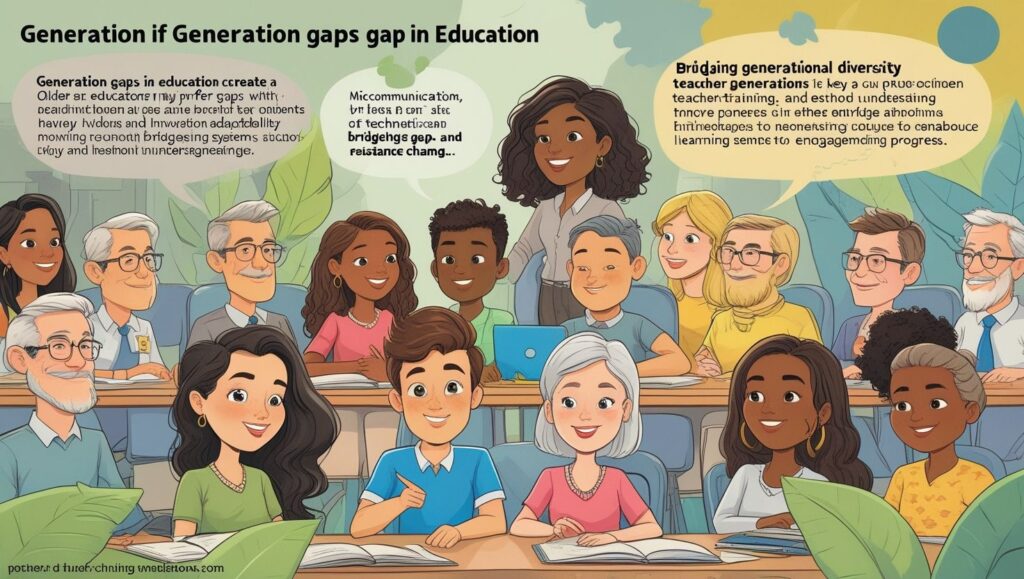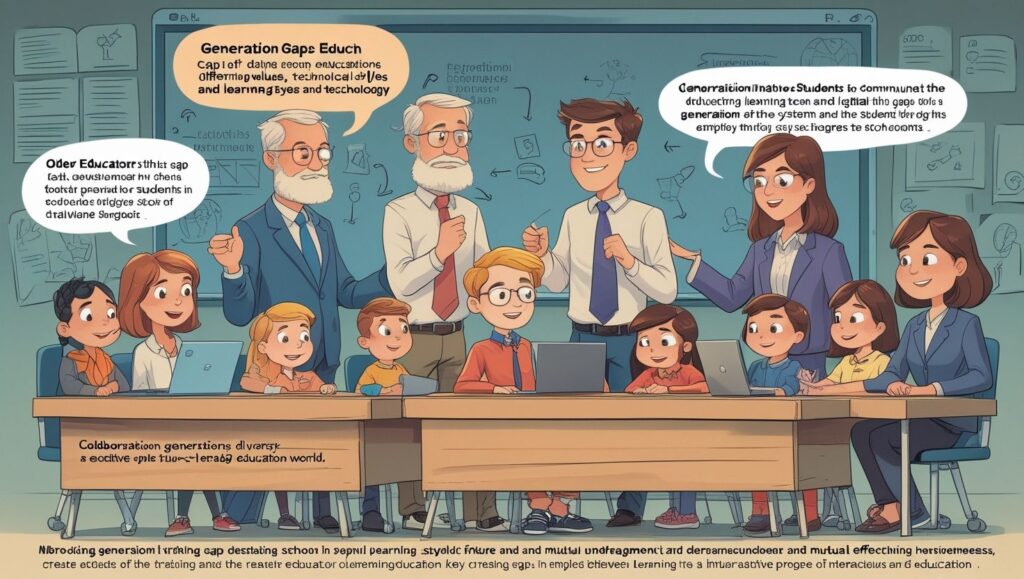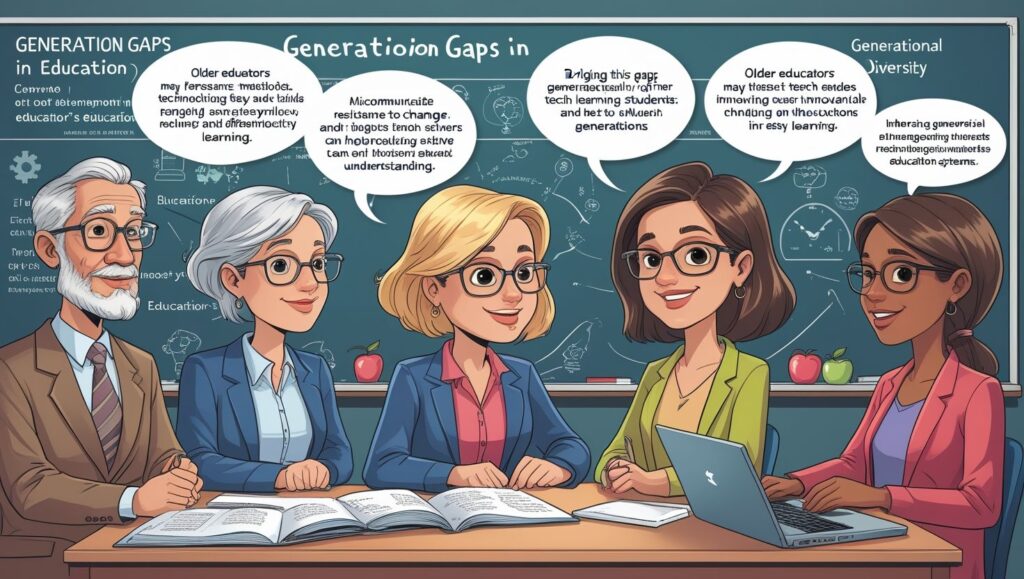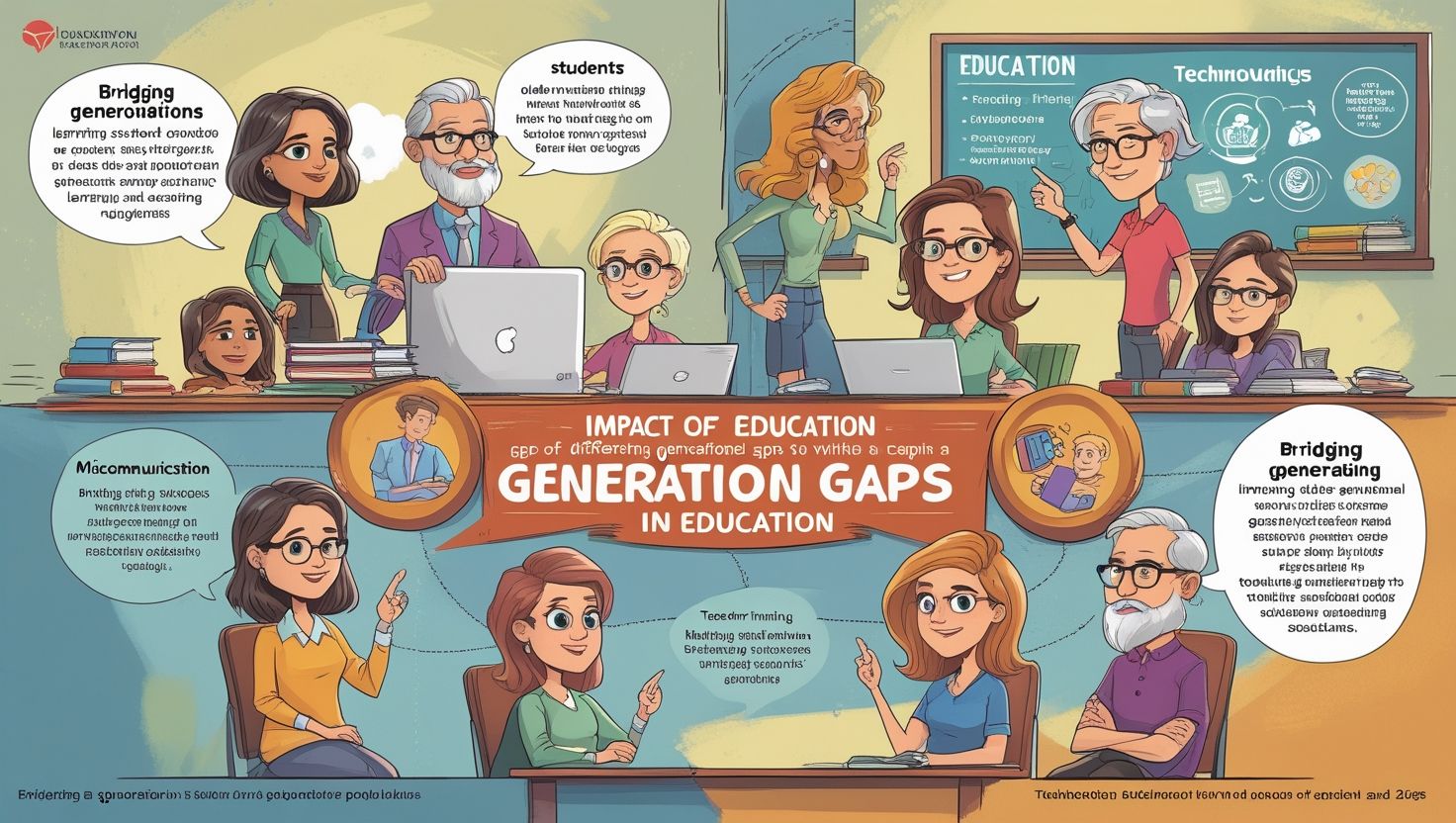1. Introduction
Impact of Generation Gaps in Education, Generation gaps in education refer to the differences in perspectives, values, and learning approaches between different age groups. In schools, these gaps often appear between teachers and students or between parents and children. They may also occur between senior and junior staff. Education systems are influenced by social, cultural, and technological changes. As a result, the gap in attitudes widens over time. Older generations often value discipline, respect, and traditional learning methods. Meanwhile, younger generations prefer technology, flexibility, and creativity in their learning process.
Moreover, these differences can create misunderstandings in classrooms. Teachers may feel students lack seriousness, while students may feel teachers do not understand modern challenges. This lack of understanding can impact teaching quality, student engagement, and learning outcomes. Additionally, parents may expect children to follow educational paths similar to their own. In contrast, students may want to explore new fields and careers.
Therefore, the generation gap must be understood as both a challenge and an opportunity. It is not only about differences but also about bridging them. Education plays a central role in creating a shared understanding. Through communication, mutual respect, and adaptation, schools can transform these differences into strengths. This sets the stage for improving relationships and learning environments for all.
2. Causes of Generation Gaps in Education
Several factors contribute to the widening generation gap in education. First, rapid technological advancements have created differences in communication and learning styles. Older teachers and parents grew up in an era with limited access to digital tools. They often rely on books, lectures, and face-to-face discussions. On the other hand, younger generations are digital natives. They prefer online resources, multimedia learning, and interactive platforms.
Second, cultural and social changes also influence perspectives. Older generations often value stability, hierarchy, and tradition. Younger generations value diversity, equality, and innovation. These differences affect how they approach education and life choices.
Third, economic transformations have changed career demands. In the past, stable jobs came from fixed educational paths. Now, job markets require continuous skill development and flexibility. Parents may struggle to accept non-traditional career options, while students see them as essential.
Additionally, generational differences in values play a role. Older teachers may focus on discipline and memorization. Younger students may focus on collaboration and problem-solving. This can create conflicts in teaching approaches.
Finally, lifestyle changes such as global exposure, media influence, and social networking have made younger generations more connected to global trends. As a result, their expectations from education differ from those of the past. These causes make bridging the generation gap a priority for effective education.

3. Positive Impacts of Generation Gaps in Education
Although generation gaps can cause challenges, they also bring many positive impacts when managed well. One major benefit is the exchange of knowledge between generations. Older teachers provide wisdom, experience, and moral values. Younger students contribute creativity, energy, and modern perspectives. This combination can create dynamic and balanced learning environments.
Furthermore, generational diversity promotes adaptability. Students learn to interact with people from different age groups, preparing them for real-world situations. Teachers also improve by adopting new technologies and methods from younger generations. This mutual learning process enriches education.
Another positive impact is innovation in teaching and learning. Older educators may introduce structured learning techniques. Younger generations may add interactive and engaging tools like online platforms, videos, and virtual simulations. The result is a more inclusive learning process.
Moreover, generation gaps can encourage critical thinking. When students and teachers challenge each other’s viewpoints respectfully, they develop deeper understanding. These discussions lead to broader perspectives and improved problem-solving skills.
Finally, the diversity of values helps shape well-rounded individuals. Students learn respect for traditions while embracing progress. Teachers gain insights into the evolving needs of students. Therefore, generation gaps, when handled with understanding, become a source of growth for both students and educators.
4. Negative Impacts of Generation Gaps in Education
While there are benefits, generation gaps also create significant challenges in education. A major issue is communication barriers. Older teachers may use formal or traditional language, while younger students prefer modern and informal expressions. This difference can lead to misunderstandings in instructions or feedback.
Another challenge is resistance to change. Some teachers may be reluctant to adopt new technologies or teaching styles. This can limit students’ learning experiences. Likewise, students may dismiss valuable traditional methods, missing important lessons in discipline and patience.
Additionally, generational gaps may create conflicts in expectations. Parents may push for stable and respected careers like medicine or engineering. However, students may prefer creative or emerging fields. Such disagreements can lead to stress, reduced motivation, and poor academic performance.
Furthermore, differences in values may create discipline issues. Older educators may view strict rules as essential. Younger students may see them as outdated and restrictive. This mismatch can affect classroom harmony.
Lastly, the gap can result in a lack of emotional connection. If teachers fail to understand students’ modern challenges, students may feel isolated. This emotional distance can weaken trust and hinder learning. Therefore, addressing these negative impacts is vital for educational success.

5. Bridging the Generation Gap through Communication
Effective communication is the foundation for bridging generation gaps in education. First, both teachers and students must practice active listening. This means paying attention, showing respect, and asking questions for clarity. Listening builds trust and reduces misunderstandings.
Second, open dialogue is essential. Schools should encourage regular discussions between teachers, students, and parents. These discussions can address concerns, share ideas, and create mutual understanding. Third, using simple and relatable language helps overcome barriers. Teachers can explain concepts in ways that connect with students’ experiences. Students can also learn to express themselves clearly and respectfully.
Moreover, adopting multiple communication channels is useful. Older generations may prefer face-to-face meetings. Younger generations may prefer digital communication like emails, messages, or online platforms. Combining both ensures better connection.
In addition, feedback should be constructive. Teachers can highlight strengths before pointing out areas for improvement. Students can share suggestions without being disrespectful. Finally, schools can organize intergenerational activities, such as debates, cultural events, or mentorship programs. These activities create opportunities for natural communication and understanding. By improving communication, schools can turn generation gaps into productive exchanges that benefit both sides.
6. Role of Technology in Reducing Generation Gaps
Technology plays a vital role in narrowing generation gaps in education. First, it provides a common platform for learning. Digital tools like interactive whiteboards, online courses, and educational apps engage both teachers and students.
Second, technology encourages collaboration. For example, group projects can use online platforms where teachers and students work together. This builds teamwork and mutual respect. Third, it offers training opportunities for teachers. Older educators can attend workshops or online tutorials to learn new methods. This helps them stay updated and confident in modern classrooms.
Moreover, technology bridges cultural and global differences. Access to online resources exposes both generations to diverse perspectives. This reduces misunderstandings based on outdated stereotypes. Additionally, technology allows personalized learning. Students can learn at their own pace, while teachers can track progress using digital tools. This flexibility satisfies both traditional and modern expectations.
However, balance is important. While technology is powerful, it should not replace human interaction. Instead, it should complement traditional methods. Schools that integrate both approaches create inclusive learning spaces. By embracing technology, schools can connect generations through shared learning experiences. This reduces conflicts, improves engagement, and fosters a culture of continuous growth in education.
7. Teachers’ Adaptation to Generational Differences
Teachers play a key role in managing generation gaps. First, they must acknowledge that differences exist. Accepting diversity in learning styles, values, and communication helps in designing better lessons.
Second, teachers should adapt their methods. Combining traditional lectures with interactive activities ensures all students remain engaged. For example, storytelling can be paired with multimedia presentations. Third, continuous professional development is important. Attending training programs or conferences allows teachers to learn modern strategies. This keeps their teaching relevant to changing student needs.
Additionally, teachers can use mentorship models. Experienced educators can guide students not just academically but also in life skills. At the same time, they can learn from students about modern trends and technology. Furthermore, understanding students’ cultural and social contexts is essential. Teachers who respect students’ backgrounds build stronger connections.
Lastly, patience and empathy are crucial. Generational differences may cause frustration, but positive relationships grow through understanding. Teachers who balance discipline with flexibility create environments where all students can thrive. This adaptation ensures the generation gap becomes a learning opportunity rather than a barrier.

8. Parents’ Role in Minimizing Generation Gaps
Parents also influence generation gaps in education. First, they should stay informed about modern educational trends. This helps them understand their children’s learning styles and career goals. Second, open communication at home is important. Parents should listen to their children’s opinions, even if they differ from their own. Respecting these views encourages confidence and trust.
Third, parents can participate in school activities. Attending meetings, workshops, or cultural events connects them with teachers and the school community. This teamwork helps align educational goals. Moreover, parents should be flexible about career choices. Understanding that job markets have changed allows them to support their children’s ambitions.
Additionally, guiding children in balancing technology use is vital. Encouraging productive online activities ensures education benefits from modern tools without excessive distractions. Lastly, parents should model lifelong learning. By taking interest in new skills or courses, they inspire children to value education at all stages of life.
When parents adapt and communicate effectively, they reduce misunderstandings. This creates a supportive environment where the generation gap becomes a bridge rather than a wall.
9. Long-term Effects of Unaddressed Generation Gaps
If generation gaps in education remain unaddressed, they can cause long-term problems. First, student motivation may decrease. A lack of understanding from teachers or parents can lead to frustration and disengagement. Second, communication breakdowns may become permanent. Misunderstandings can create mistrust between generations, making cooperation difficult.
Third, outdated teaching methods may remain in place. Without adaptation, students may miss out on skills needed for modern careers. This can affect their future employment and confidence. Additionally, discipline issues may increase. Conflicts over rules and expectations can create tense learning environments.
Moreover, emotional well-being may suffer. Students who feel misunderstood may experience stress, anxiety, or low self-esteem. Teachers may also feel burnout when they cannot connect with students. In the long term, the education system may struggle to meet the needs of future generations. Without bridging the gap, schools risk producing graduates unprepared for global challenges. Therefore, proactive measures are essential. Addressing the generation gap ensures education remains relevant, inclusive, and effective for all learners.
10. Conclusion: Turning Gaps into Bridges
The generation gap in education is a reality shaped by differences in values, technology, and culture. While it can cause misunderstandings, it also offers opportunities for growth. By promoting open communication, using technology wisely, and adapting teaching methods, educators and parents can transform the gap into a bridge.
Mutual respect is key. Teachers can blend traditional wisdom with modern techniques. Students can value heritage while embracing progress. Parents can support evolving career paths while guiding with experience. Education thrives when all generations work together. Schools that create inclusive spaces prepare students for diverse real-world environments. The goal is not to eliminate differences but to learn from them.
When the generation gap is approached positively, it strengthens relationships, improves learning, and builds a more understanding society. Ultimately, turning differences into shared strengths ensures that education serves both the present and the future.

Cappadocia Cave hotels Alexander B. ★★★★☆ Sunset at Red Valley viewpoint was crowded. Guides should know secret photo spots. Otherwise flawless honeymoon package! https://naya.social/read-blog/11640
Underground Cities Turkey Charlotte M. ★★★★★ Hot air balloon + champagne breakfast combo! Watching 100+ balloons rise while sipping Turkish sparkling wine – bucket list DONE. https://japanesewatergardens.com/2025/07/13/cappadocia-tours-2025/
Dazu wählst du einfach ein Spiel aus der Liste aus und folgst
dem Link – das Gratisspiel wird direkt in deinem Browserfenster geladen.
Es liegt daher in der Verantwortung des Spieler, die örtlichen Vorschriften zum
Thema Online-Glücksspiel zu überprüfen, diese Seite
übernimmt keine Verantwortung für Ihr Handeln. Rubbelkarten oder
Rubbellose etwa sind ein schnelles Glücksspiel
mit Sofortgewinnen.
Fishin’ Frenzy Megaways bietet den Fisherman Free Games Bonus, bei dem die Spieler den Nervenkitzel genießen können, Fische
zu fangen, um ihre Gewinne zu steigern. Das lebhafte Thema,
das im Reich der Angler spielt, wird durch eine Reihe passender Symbole
dargestellt, während die visuellen und akustischen Elemente des Spiels eine lebendige Atmosphäre schaffen. Diese Spiele können Sie unter „Beliebteste Spiele” auf dieser Seite finden. Ein mögliches Selektionskriterium ist, welche Spiele auch bei anderen Spielerinnen und Spielern gut ankommen und gerne von diesen gespielt werden. Hier stellen wir Ihnen vier beliebte Themen vor, die Sie in der Liste „Spielthemen” in den erweiterten Filtern auf dieser Seite finden können.
References:
https://online-spielhallen.de/wazamba-casino-deutschland-ein-umfassender-testbericht-fur-deutsche-spieler/